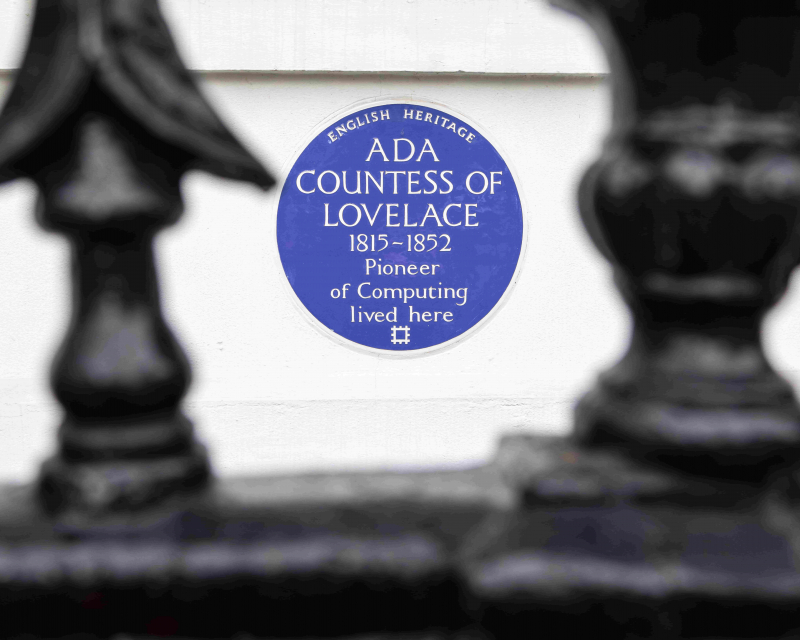Bachelor's student
The Women of Computer Science
We are all familiar with the now-household names of the pioneers and revolutionaries of computer science: Alan Turing, the inventor of the eponymous theoretical machine, Tim Burners-Lee, the creator of the World Wide Web, and Dennis Richie, James Gosling, Guido van Rossum, and Bjarne Straustrop of C, Java, Python, and C++ fame, respectively. What is sometimes overlooked, however, is the role of women in the emergence and development of the now-prodigious discipline.

Ada Lovelace
Ada Lovelace (1815−1852) was born in London to Annabella Milbanke and the poet Lord Byron. As a child Ada, like her mother, received mathematical training. Her interest in what would now be called computer science arose at the age of 17 when she met the mathematician Charles Babbage, who demonstrated to her a part of his proposed mechanical computer, known as the Analytical Engine.
Ten years later she translated an article on the Engine by the Italian engineer Luigi Menabrea. Of note are the comments she made about the machine, which included a sequence of operations that could be employed to solve certain mathematical equations — a "program", if you will. She is thus referred to by some as the first programmer.

Perhaps more intriguing is her assertion that the Engine "might act upon other things besides number, were objects found whose mutual fundamental relations could be expressed by those of the abstract science of operations… Supposing, for instance, that the fundamental relations of pitched sounds in the science of harmony and of musical composition were susceptible of [mathematical] expression and adaptations, the engine might compose elaborate and scientific pieces of music of any degree of complexity or extent." Lovelace was therefore one of the first — if not the first — to see the immense potential of the general-purpose computing machine.
Margaret Hamilton
Margaret Hamilton is a software engineer from Paoli, Indiana. After graduating from Earlham College in Richmond, Indiana in 1958, she decided to move to Boston to pursue an abstract mathematics degree at Brandeis University, but instead accepted a job offer from MIT. There, Hamilton spent some time modeling meteorological phenomena before joining the Semi-Autonomous Ground Environment (SAGE) project. SAGE was the US’s first air defense system, and there she worked on software that could be used to identify hostile aircraft.
Hamilton next worked at MIT’s Instrumentation Laboratory, where she and her team of programmers developed code for the many control and guidance systems of the various spacecraft of the Apollo missions. Interestingly enough, it was then that she coined the term "software engineer" to describe what the team was doing. Their work was essential to the success in 1969 of the Apollo 11 mission, which put mankind on the moon.

After working on several of the remaining Apollo missions and Skylab, the US’s first space station, she left MIT in the 1970's and co-founded Higher Order Software in 1976 and Hamilton Technologies in 1986, the latter of which provides "products and services to modernize the planning, system engineering and software development process in order to maximize reliability, lower cost and accelerate time to market."
The significance of Hamilton’s contributions has been recognized by many institutions, including NASA with the Exceptional Space Act Award in 2003, and the White House with the Presidential Medal of Freedom in 2016, awarded by Barack Obama.
Barbara Liskov
 Barbara Liskov is an American programmer and computer engineer. She was born in 1939 in Los Angeles, California. In 1961 she earned a Bachelor’s Degree in mathematics from the University of California at Berkeley. The next few years she spent working as a programmer in Boston for the Mitre Corporation and Harvard University. In 1968 Liskov became the first woman in the US to receive a Ph.D. in computer science when she completed her degree at Stanford, where she worked on artificial intelligence with John McCarthy.
Barbara Liskov is an American programmer and computer engineer. She was born in 1939 in Los Angeles, California. In 1961 she earned a Bachelor’s Degree in mathematics from the University of California at Berkeley. The next few years she spent working as a programmer in Boston for the Mitre Corporation and Harvard University. In 1968 Liskov became the first woman in the US to receive a Ph.D. in computer science when she completed her degree at Stanford, where she worked on artificial intelligence with John McCarthy.
Liskov joined the faculty of MIT in 1972, and in the decades that followed she was involved in a number of important projects, including the development of the Venus operating system, the Argus and CLU programming languages, and the Thor database system.
She is perhaps best known for the Liskov Substitution Principle, which defines that a subclass should behave identically to its superclass. The "L" in SOLID, her work has been a pillar of object-oriented programming for decades. In 2008 Liskov received the Turing Award in recognition of her myriad lifetime achievements in the fields of mathematics and programming.
Here we have looked at three of the many unsung heroines of computer science: from one of the first people to see the potential of the machines which now govern our lives, to the person who helped usher in the age of space exploration, to the software engineer who paved the path for object-oriented programming. These women will doubtless be role models for young minds for many generations to come.
